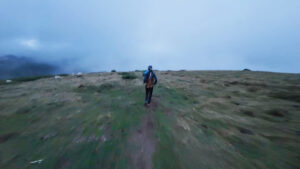Four Masted Barque Rounding Cape Horn is a dull title for a flamboyant compendium of live-action footage of life aboard a monstrous cargo vessel in 1928, all captured and curated by a young captain, Irving Johnson.
In 1980, Johnson compiled his collection, added his own narration, and created this energetic, one-of-a-kind film. It’s informative, humorous, full of action, and remarkably well documented — even by today’s adventure film standards.
Captain Irving Johnson

Irving Johnson, c. 1980. Photo: CC
American captain Irving Johnson was a colorful adventurer, sail training pioneer, speaker, and writer.
The documentary opens with a reel of Johnson riding boneshaker and big-wheel bicycles on his family’s farm in Hadley, Massachusetts. (The footage includes an over-the-handlebars face plant.) He then proceeds to scale a rotted, wobbling electrical pole, and pulls off a pearl-clutching, hands-free headstand once at the top “to make sure he’d never be scared.”
He did all of these things to get in shape for his lifelong ambition — a maritime voyage to Cape Horn.
“Now there’s a boy with a one-track mind if you’ve ever seen one!” the elder captain exclaims. “I got ready for it on the farm before I’d even seen saltwater.”
The Peking
Johnson set sail for Cape Horn aboard the Peking, the largest sailing ship in the world, and one of the last cargo vessels ever used in the nitrate-and-wheat trade around Cape Horn.
Built by F. Laesiz company in 1911, the film’s titular steel-hulled, four-masted bark weighed 3,100 tons when bone-dry (which it never was), donned more than an acre of canvas across its 32 sails, and ran entirely off human and wind power. It had benefited Germany and Italy by the time Johnson joined its ranks.
The crew stuffed its cargo hold with 5,300 tons of goods and set off on a 17,700-kilometre voyage from northern Ireland to South America’s southernmost tip.

The restored ‘Peking’ in 2020. Photo: CC
Sailing to Cape Horn, 1928
The Peking spent 17 hectic days in the North Sea. Storms battered the ship, sometimes submerging its rails up to nine metres underwater. Drenched but seemingly cheerful sailors dumped out the water from their galoshes between turns at managing the great bark’s 315 lines. The only way to dry one’s clothes? By sleeping in them.
“There’s something about these vessels that causes a kind of hypnotism! You can do things you’d never dream of doing on land,” Johnson enthuses in the film.
Mending sails — Johnson tells us they’d learned to sew seven metres of canvas an hour at “racing speed” — lining up for weekly trims, harvesting shark, and sharing four-on/four-off shifts knit the crew together tightly.
In unfavorable weather, the Peking could sail at speeds up to 16 knots with, as Johnson notes, the help of her crew. “We felt like Superman!” said the extroverted skipper. “We made all of this happen!”

A sailor tends to the lines as seawater envelopes the Peking’s deck. Still: Irving Johnson
After weathering one last nautical storm, the crew approached Cape Horn — and then the Peking came to a lulling halt. The wind had literally been taken out of its sails. Foggy, warm, still air enveloped the ship for a week or so. The crew was forced to mitigate the current without so much as a breeze, causing the Peking to pulse to and from the Chilean coast.
He wanted to experience a storm
“I’m disgusted with the weather.” Johnson’s narration showcases the exasperation he felt as a greenhorn. “I came all these thousands of miles to get a big ‘storm-off’ coupon.”
And then came the storm he’d always wished for. And a second storm. Johnson, miraculously, provides comprehensive footage from high up on a mast. “Now watch this,” he prompts us, “the bottom of Niagara Falls looks exactly like what you’re gonna see here.”
So what did the young sailor learn? And did the Peking ever make it to the port of Cape Horn? You’ll just have to see for yourself.
Runtime: 38 minutes






